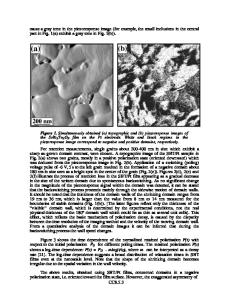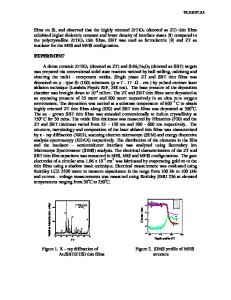Pulsed Laser Deposition of SrBi 2 Ta 2 O 9 Thin Films for Nonvolatile Memory Applications
- PDF / 283,272 Bytes
- 6 Pages / 414.72 x 648 pts Page_size
- 87 Downloads / 344 Views
S. WERNER*, D. THOMAS*, KINGON*
S.K. STREIFFER*, 0.
AUCIELLO*,**, ANGUS I.
*North Carolina State University, Department of Materials Science and Engineering, Raleigh, N.C. 27695 **MCNC, Electronic Technologies Division, 3021 Cornwallis Rd., Research Triangle Park, N.C. 27709-2889
ABSTRACT Ferroelectric SrBi 2 Ta 2O 9 (SBT) thin films were synthesized by pulsed laser deposition (PLD) on platinized silicon substrates held at different substrate temperatures, from targets with different compositions. It was necessary to anneal films deposited at low temperature (525°C) at elevated temperatures in an oxygen atmosphere in order to achieve properties comparable to SBT thin films grown by the sol-gel technique. Polarization - electric field hysteresis loops showed saturation in the 2-5 V range with a remnant polarization 2 Pr = 8-13 pLC/cm 2 . Capacitors showed negligible fatigue up to 1010 switching cycles. INTRODUCTION It is known that ferroelectric Pb(ZrxTi 1-x) 0 3 (PZT) thin films with Pt electrodes exhibit a decrease of switchable polarization with increased number of switching cycles (fatigue), while less fatigue is observed for PZT thin films with oxide electrodes [1]. However, PZT with oxide electrodes often displays unacceptably high leakage currents. One attractive solution to overcome this problem is the use of hybrid electrodes [2]. Another approach to produce low-fatigue nonvolatile capacitors is the use of layered perovskite ferroelectrics as alternatives to PZT. Hence, there has been growing interest in using such materials in capacitors for ferroelectric random access memory (FRAM) applications. SBT is one member of this family of compounds (Aurivillius [3]) and has been integrated with platinum electrodes to produce capacitors with little or no fatigue [4]. Until recently, SBT films have primarily been produced using sol-gel processing [5]. Unfortunately, this generally requires a high-temperature processing step. In an effort to lower the maximum temperature necessary to produce material with acceptable properties, we have synthesized SBT thin films by PLD, and investigated the microstructure and electrical properties in relationship to deposition temperature and the Sr/Bi ratio of the target. Ferroelectric properties and the endurance of the layered perovskite films were determined by hysteresis and pulse measurements, respectively.
235 Mat. Res. Soc. Symp. Proc. Vol. 397 0 1996 Materials Research Society
EXPERIMENTAL Ablation was performed using a Lamda Physik LPX 300 excimer laser utilizing KrF radiation (248 nm). For these experiments, three targets with different stoichiometry were chosen: stoichiometric SrBi 2 Ta 2 O9 (obtained from Seattle Specialty Ceramics, Inc.), SrBi2. 2 Ta 2O9+x, and Sro.7Bi2.4Ta2O9+x. The latter two were produced by powder preparation in our laboratory. The energy density on the target was 1.1 J/cm 2 and the laser was operated at a frequency of 3 Hz. During deposition the target was rotated at a speed of 30 rpm. Platinized Si substrates were mechanically clamped onto
Data Loading...











